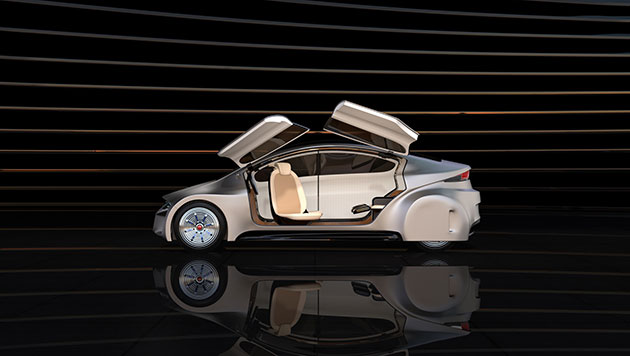Self-driving cars are good.
We currently stand at a strange time for transportation, straddling two worlds, at the precipice of a transitional period not seen since the invention of the car itself. Autonomous autos are coming, and they will impact us in a multitude of ways, especially as our human-operated vehicles are phased out.So good that they could be the worst thing to happen to our roads.
Giving up our collective driver’s seat could bring a machine-like precision to the streets, keeping things running so smoothly that any bumps in the road we experience now—accidents; agonizing traffic—will likely be long forgotten.
Or completely exacerbated.
The idyllic scenario of well-programed machines dancing in perfect time to keep us moving as efficiently as possible could prove too good to be true. The cars could gain so much popularity that more vehicles will be needed to accommodate a growing number of passengers—throwing off the delicate balance of supply and demand in a way that could clog even the most well-run road.
One in A Million
With the technology due to hit the showroom circuit in just a few years, it’s worth wondering whether self-driving cars will help us finally overcome traffic—or, in doing so, cause even more of it.
The presence of just a single autonomous vehicle in a group of more than 20 cars was enough to curb traffic build-up in a new study conducted by the University of Illinois.
Highway congestion can be a lot like a Seinfeld episode: After the half hour (or more) it takes to get through it, you realize, in the end, the whole thing was about nothing.
But just as one car can slow down an entire roadway, it only takes one to keep things moving.The phenomenon is called a “phantom traffic jam,” and nearly everyone who has logged time on American roads has experienced it. That’s because its origins are purely man-made: One car ahead of the line taps the brakes, for no apparent reason, sending a shiver down the highway’s spine, with every subsequent driver, in turn, pumping their own brakes and bringing the whole thing to a collective halt.
The presence of just a single autonomous vehicle in a group of more than 20 cars was enough to curb traffic build-up in a new study conducted by the University of Illinois.
The trick, according to the study, is the driverless vehicle’s ability to regulate its speed during a phantom jam, allowing for the flow of traffic to continue down the line and reducing the need for others behind it to hit the brakes.
All told, the self-driving car helped cut the standard deviation in speed for the other vehicles in the congestion by 50%—meaning the autos were able to keep cruising at a decent clip throughout the jam. That’s likely because the smart driving of the autonomous car led to less braking for everyone, bringing the number of times the other autos slammed on the pedal from about 9 per vehicle per kilometer to 2.5—at most.
And the effect does more than help save people time. It can help save the environment.
Continually slowing down and speeding back up is a drain on fuel, but the streamlined traffic produced by the presence of the autonomous car in the study resulted in a nearly 40% reduction in fuel consumption across the board. (And this is with gas guzzlers. Emissions-saving possibilities could skyrocket with electric self-driving cars.)
Extrapolate that potential out to millions of vehicles—and factor in the idea of connected infrastructure helping to regulate things from an even greater vantage point—and we may soon create a peaceful flow that we’d all happily surrender to.
But that’s just the problem.
Paved with Good Intentions
Every action has an equal and opposite reaction. In the world of traffic flow, the elimination of the dreaded phantom jam could be balanced out by a phenomenon called “induced demand.”
The idea, in a nutshell, is that production begets popularity, which, in turn, calls for more production, in a reversal of the usual supply-and-demand dynamic. The more of something there is, in this model, the more people want it.
If the autonomous experience is made widely available, and people prove fond of it, more cars will be needed to continue facilitating it, which would give more people exposure to self-driving cars, making the experience even more popular.
The only problem: There’s only so much room for roads in the world.
And autonomous vehicles are already forecasted to be a hit.
A recent study conducted by the University of Leeds predicted that self-driving cars could boost the number of miles driven each year by 60%. Another report put together by the Atlanta Regional Commission estimated that both the number of daily trips and average trip length in a car would increase by 2040, due to the ease of autonomy. At the same time, the report says, public transit rides could dip as much as 42%.
With the ability to drive no longer a prerequisite to cruising the highways, the new-age tech could also open up road travel to people not currently willing—or able—to take advantage of it, including the elderly, disabled, and, of course, the millennials who have resoundingly rejected the idea of getting behind the wheel, logging up to 25% fewer miles per year than their older counterparts and getting their licenses to the tune of 20% less frequently, according to a recent study on the matter.

One possible way to keep such potentially explosive demand in check is by imposing “congestion pricing,” according to James Anderson, director of the Justice Policy Program at the RAND Institute for Civil Justice.
“When you drive, you’re creating more congestion, but you don’t get charged for it, so as a result, you often have overuse in roadways,” he said. “That results in even more congestion, and the enormous costs of that—billions of dollars for motorists in traffic—is completely inefficient. You could do various things to address those inefficiencies in the existing transportation system, by creating different incentives for the kind of autonomous future we want to have, like some form of congestion pricing.”
While it’s unclear exactly how such a system could be implemented, attaching any extra costs to spending time in the car could help condition people to use that type of transportation more frugally, relieving some roadway traffic, Anderson said
“If you essentially tried to impose the true costs of the use of the vehicles on the purchasers, you’d end up with a more efficient system.”
But what happens if the world around the system also changes, making resistance impossible?
A Whole New World
Self-driving cars have the potential to change everything about how—and where—we live.
Some experts fear the vehicles could lead to an outcrop of suburban sprawl, with communities built increasingly farther away from the city centers their residents work in as the ride to the office becomes less taxing and, therefore, more enticing.
The rise of autonomous technology would likely also mean the elimination of the driver’s license, with no need to any longer accumulate a skill our machines will have taken up so adeptly.
All told, an entire societal structure could arise making people wholly reliant upon self-driving cars. Living a greater distance from their jobs, without the options to get there another way, doesn’t create demand, it creates dependency.
The greater efficiency of autonomous vehicles could ultimately be their undoing, leaving us in deadlock traffic oceans all over again.
As we ride out this sea change in our transportation history, all we can do is hope that the current is kind.
